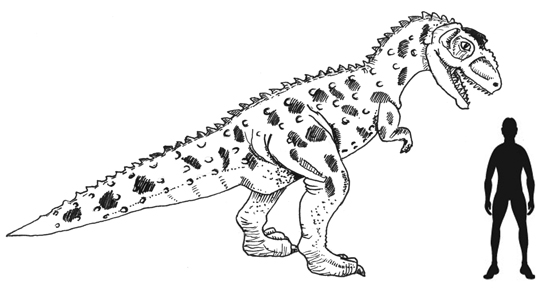Massive Abelisaurid from Morocco
A partial femur (thigh bone) found in Morocco has provided palaeontologists with yet more evidence of the amazing diversity of theropod dinosaurs that flourished in North Africa during the Middle Cretaceous. The fossil, measuring around 33 centimetres in length has been identified as coming from a large abelisaurid. Based on thigh bone comparisons with better known Abelisauridae, dinosaurs such as Carnotaurus and Ekrixinatosaurus (both from the Late Cretaceous of Argentina), scientists have estimated that this meat-eating dinosaur measured around nine metres in length and may have weighed as much as two tonnes.
A Large Abelisaurid
The Partial Femur of the New Dinosaur
Picture credit: PeerJ.com
The picture above shows various views of the partial dinosaur thigh bone.
Key
(A) a proximal view, that portion of the femur that would articulate with the hip region.
(B) an anterior view, the view of the front side of the bone.
(C) in medial view.
(D) a posterior view, a view of the rear side of the bone.
(E) the lateral view.
(F) a distal view, the part of the thigh bone that would be furthest away from the trunk of the animal, that part of the bone closest to the lower leg bones. Please note, the scale is different for picture (F).
The scale bar (white bar) is five centimetres. Abbreviations gt, greater trochanter; iMie, insertion for the Musculus iliofemoralis externus (a muscle and subsequent muscle scar); fn, femoral neck; s, shallow sulcus.
From the Geological Museum in Palermo
The fossil is part of the collection at the Geological Museum in Palermo (Italy) and a paper on the femur has just been published in the on line, open access journal (PeerJ). The scientific paper has been co-authored by PhD student Andrea Cau of Bologna University and fellow PhD student Alfio Alessandro Chiarenza (Department of Earth Science and Engineering, Imperial College London).
An Illustration of a Typical Abelisaurid Theropod Dinosaur
Picture credit: Everything Dinosaur
For models of abelisaurids and other theropods: CollectA Age of Dinosaurs Popular Models.
Stromer’s Riddle
The fossil is from the Kem Kem Formation of Morocco, that part of the deposit that has been dated to the Cenomanian faunal stage or the Cretaceous (Cenomanian faunal stage around 100 million to 93.5 million years ago approximately). The beginning of the Cenomanian marks the start of the Late Cretaceous as defined by the International Commission on Stratigraphy. The scientific paper concludes that the abelisaurids had indeed reached their largest body size by the “Middle Cretaceous” and that abelisaurs did co-exist with a number of other gigantic Theropods in Africa during this time.
Different Types of Meat-eating Dinosaur were Coeval
The number of different types of meat-eating dinosaur all living together in Africa during this part of the Cretaceous has posed a puzzle for palaeontologists. The puzzle is named after Ernst Freiherr Stromer von Reichenbach, the German palaeontologist who first brought North African dinosaurs to prominence. Spinosaurids, members of the Ceratosauria clade (Deltadromeus), Carcharodontosauridae dinosaurs and abelisaurids all seem to have been present in this part of the world.
The researchers examine this phenomenon and using comparisons with theropod lineages from South America, they deduce that these large super-predators probably did not overlap, with a number occupying different niches in the food chain, or living in different habitats. Niche partitioning did very probably occur, however, studies of the skulls and teeth between abelisaurids and the carcharodontosaurids such as the mighty Carcharodontosaurus iguidensis indicates that these types of dinosaurs did probably compete directly for resources.
Further fossil finds and more research will need to be undertaken before a better understanding of the interactions between these theropods can be achieved.








Leave A Comment